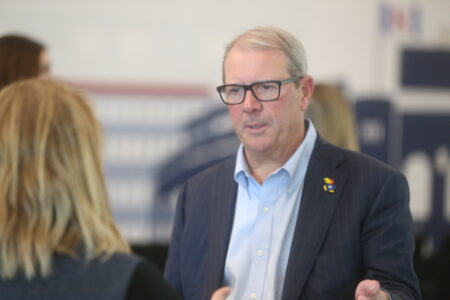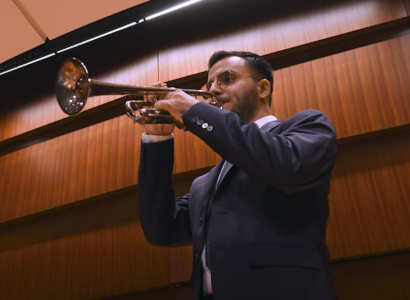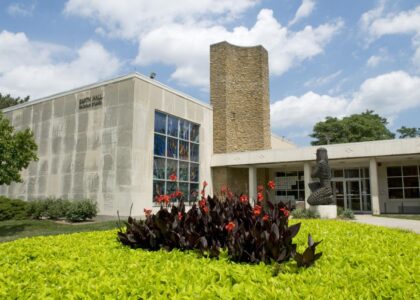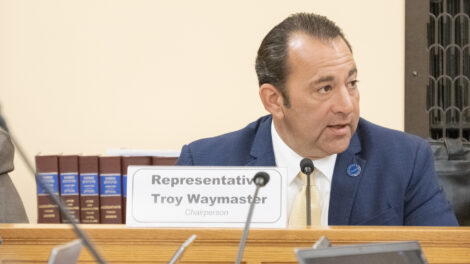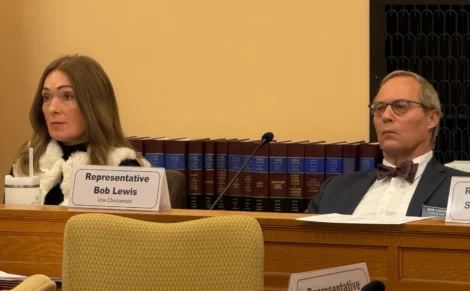‘Driving everybody crazy’: Girod speaks on status of college sports, worries over how to pay athletes

photo by: Journal-World
KU chancelor Doug Girod cheers on the Jayhawks in their game against Oklahoma at Allen Fieldhouse, Jan. 30, 2019.
All the preparations are being made for universities to begin directly paying their student-athletes next school year.
The federal judge overseeing the key lawsuit in the matter hasn’t yet approved the settlement agreement between the NCAA, universities and aggrieved student-athletes, but earlier this month she did provide indications that she intends to do so.
The NCAA on Monday, took a step in that direction too. It approved a series of rules that eliminates the prohibition of directly paying student-athletes. Those new rules will go into effect on July 1, as long as the court settlement is approved by then.
But at the University of Kansas, there is a preparation that remains uncompleted: Finding the account with $20 million in it.
That’s roughly the amount that universities would be allowed — but not required — to pay student-athletes in total during year No. 1 of the settlement. Months ago, KU Chancellor Douglas Girod told the Journal-World he was concerned that the athletic department would not be able to find that sum of money to pay student-athletes. In a brief interview last week, he said there is still not a plan for how the university would make those payments.
“We don’t have $20 million a year laying around in any pockets waiting to be deployed,” Girod said.
In fact, the fiscal year 2025 budget for Kansas Athletics — the university-controlled entity that runs KU’s sports programs — has a $16 million deficit, as the Journal-World reported in November. The deficit is partly the result of KU playing its home football games in Kansas City last season while David Booth Kansas Memorial Stadium was under construction. The loss of home games meant a loss of revenue, and created additional expenses related to the use of Kansas City’s Arrowhead Stadium during fiscal year 2025, which began in July of 2024.
Girod said Kansas Athletics is currently going through an “extreme efficiency exercise,” meaning it is looking at possible budget cuts and other spending adjustments.
“We will have to see where that ends up,” Girod said.
Girod has noted before that it is not required that KU hit the maximum $20 million cap that schools are allowed to spend on student-athlete pay. As the settlement is structured, schools will be allowed to pay up to that amount, but the settlement doesn’t require schools to provide any revenue sharing with student-athletes.
However, conventional wisdom in college athletic circles is that schools that want to attract the top talent for their programs will need to spend every dollar they can to attract student-athletes. Anything less likely will mean they will lose out on bidding wars for the services of star athletes.
In the most recent interview, Girod said he did see one possibility for KU to come up with new money to fund a revenue sharing program with student-athletes. He said if donors who currently are contributing to privately run Name, Image and Likeness collectives could instead be persuaded to donate those funds to the athletic department, that might be a path forward for KU.
But Girod said it is “unclear whether that develops that way or not.” The scenario is a possibility because the NIL rules surrounding college athletes are set to change, if the lawsuit settlement is approved. Businesses and individuals who are deemed to be “associated” with the university — think large donors or businesses who have a mission of helping schools with recruitment efforts — will have limits placed on how much they can give a student-athlete through NIL. Those deals will have to go through a third-party review that determines the amount is consistent with the fair market value of similar promotional work.
It is unclear, however, whether KU donors currently are spending anywhere close to $20 million in NIL deals with KU student-athletes. Under the current rules, universities aren’t technically a party to any NIL agreements with a student-athlete, which means there’s no official database showing how much money is being spent on NIL deals at various schools.
Various national journalists have reported numbers based on information they received from sources, and last year there were reports that members of the Kansas men’s basketball team collected $5 million in NIL payments.
But various KU players have pushed back on those numbers. Men’s basketball player Hunter Dickinson, largely assumed to be the largest NIL earner on the KU team, said on a national podcast earlier this month that it was a running joke among the team that they were collecting $5 million in payments. Dickinson said during his two-year stay in Lawrence that he made less than $1 million per year in NIL money.
“Obviously everybody thinks Kansas has all this money,” Dickinson said this month on the Field of 68 podcast. “We weren’t even in the top 15. We weren’t even probably in the top 25 in NIL spending. But they came up with the rumor we spent $5 million last year and we were all on the bus like, ‘(Expletive), who got the 5 million?'”
If Kansas donors aren’t spending anywhere close to $20 million on NIL deals, then the plan of getting NIL funders to switch their money to Kansas Athletics donations may not do much to fill the $20 million hole facing the the athletic department.
What is clear is that the current environment is stress-inducing for everyone involved in college athletics, Girod said.
“It is a very distorted environment right now,” Girod said. “I know it is incredibly frustrating for coaches, the (athletic directors,) and probably even the athletes, quite honestly, because there is so much confusion.”
Girod said the current environment is particularly wild because unlimited NIL deals are still legal, and athletes are expecting revenue-sharing deals to become legal for the next school year. That has athletes currently getting major-dollar deals both from NIL and an expected payment from a future revenue share program.
“That creates the most chaos we have ever seen in college athletics, for this specific year,” Girod said.
The chancellor, who currently is the vice-chair of the Big 12 Conference, said he does think the pending lawsuit settlement, known as the House suit, will make for a better environment, in some ways. Girod said student-athletes and universities likely will be able to have truly binding contracts after the settlement is approved.
Those contracts could reduce the large number of transfers that are occurring after each sports season. It also could prevent situations like the one that occurred at the University of Tennessee this month, where last year’s starting quarterback left the program just before the team’s spring game, reportedly over a dispute about NIL money. That late departure created concerns at other universities that their NIL partners would have to come up with new money at the last minute to ensure their quarterback didn’t leave to fill the quarterback void at Tennessee.
“I do believe the House settlement will create more structure that doesn’t exist right now,” Girod said.
Girod said such structure is critical for the future of college athletics.
“This is not a viable environment,” Girod said. “It just isn’t. Nor is it sustainable. I credit (Athletic Director Travis Goff) and his team for doing the best they can with it, but it is driving everybody crazy right now.”


